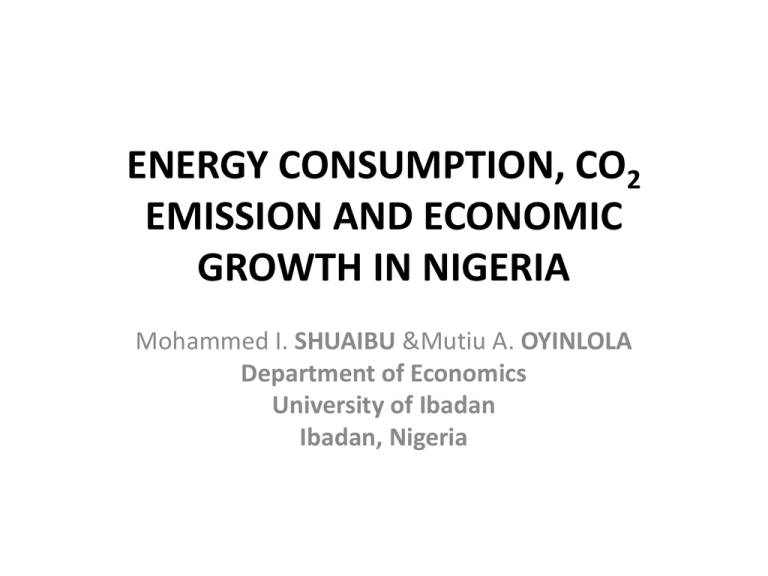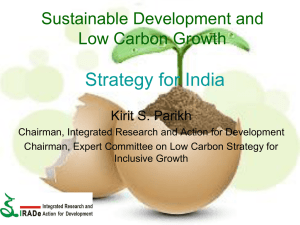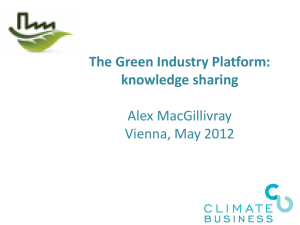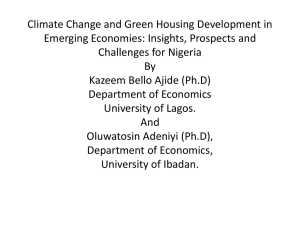energy consumption, co2 emission and economic growth in
advertisement

ENERGY CONSUMPTION, CO2 EMISSION AND ECONOMIC GROWTH IN NIGERIA Mohammed I. SHUAIBU &Mutiu A. OYINLOLA Department of Economics University of Ibadan Ibadan, Nigeria Preamble • Proponents of global warming have argued that global emissions of carbon dioxide (CO2) remain a major source of global warming. • Indeed, CO2 emission has increased by 3% in 2011, reaching an all-time high of 34billion tonnes (NEAA, 2012). • The alarming threat and attendant consequence of climate change on economies make this nexus contentious. • Energy Use: Crucial to economic prosperity. • YET adequate attention to optimal energy use to minimise pollutant emission Preamble • Nigeria: 6% average growth (last decade). • In spite of this remarkable development, the supply of electricity which remains the main source of energy in Nigeria is fitful. • This has led to a shift to other alternative sources of power which require burning of fossil fuels and has consequently increased toxic emissions. • Worrisome trend! Preamble • The energy consumption index in Nigeria increased from 2.8% in 2010 relative to the increase and dip of 4.9% and 1.9% observed accordingly in 2008 and 2009. • In absolute terms, energy consumed stood at 19.1million tonnes of coal equivalent (TCE) in 2010, from 20.4million and 18.3million TCE in 2008 and 2009, respectively (CBN, 2009, 2010). • Consequent upon above, emission of green house gases stood at a staggering 49.6 and 41.2million tonnes in 2008 and 2009. • In sum, the average change of pollutants emitted between 1990 and 2009 was 41.3%. Motivation • • • • • • • This rather appalling scenarios, inter alia, stimulate this study. Similar studies: Binh, 2011, for Vietnam; Omotor, 2008; Omisakin, 2008; Odularu and Okonkwo, 2009; Dantama et al. 2012; Olusanya, 2012; for Nigeria). Focus: the effect of energy and/or electricity consumption on economic growth, neglecting the consequence of persistent energy depletion in form of CO2 emission on the economy. However, the study by Chebbi (2009) for Tunisia, Menyah and Wolde-Rufael (2010) for South Africa, Tiwari (2011a, 2011b) for India, Akpan and Akpan (2012) for Nigeria, are notable exceptions. Methodology: Johansen and Juselius or Engle and Granger cointegration and/or Granger causality approach especially for studies carried out in Nigeria. We depart from these approaches and propose to use the Gregory-Hansen cointegration test and the Toda-Yomamato causality test. Why?: These studies ignore the possible effects of structural breaks which may have an effect on energy consumption. Motivation Cont’d • The Gregory and Hansen (1996) tests for structural break cointegration allows for cointegrating vectors to change at an unknown time period. • This is in view of the fact that, in general, failure to account for breaks can produce misleading tests leading to incorrect inference. • The Granger non-causality test using the Toda-Yomamoto (T-Y) procedure which is applicable regardless of whether a series is I(0), I(1) or I(2), not-cointegrated or cointegrated of any arbitrary order. • This implies that it avoids the potential bias associated with unit root and cointegration tests (see Rambaldi and Doran, 1996) which most studies have used. Objectives and Expected Outcomes • To develop and test an econometric model to identify the main economic fundamentals surrounding the interplay between economic growth, CO2 emission and energy consumption in Nigeria. • To examine the long- and short-run effect of CO2 and energy consumption on economic growth. • Apriori, we expect a positive relationship between energy consumed and growth while a negative relationship is expected between CO2 emission and growth. For labour and capital, the other control variables, we expect a positive association with growth. Stylized Facts • Climate change is a global phenomenon and its impact in form of unusual and extreme weather conditions is evident in Nigeria. • This has primarily been induced by depletion and consumption of energy resources which in turn result in CO2 emissions. • Nigeria ranks 38 amongst the global community of nations in terms of CO2 emissions. • The Nigerian economy has over the years been heavily dependent on oil as it account for over 95% of governments’ export earnings and 40% of revenue inflows. The consumption of refined petroleum products, biomass and electricity has over the years dominated Nigeria’s energy consumption mix. • While significant and stable growth rates have been recorded in the last decade, emission of green house gases has been on the rise given the expansive energy consumption that accompanied growth. Stylized Facts Cont’d • • • • • • • Emissions in metric tonnes per million US$ of GDP in Nigeria as at 2004 stood at 762 at purchasing power parity in 2000USD while the emissions per capita (tons per person) was 0.73 (World Bank, 2007). This was probably due to a faster increase in the use of gas (especially) and oil than of coal. Nigeria and Brazil are examples where this effect was dominant in the total change of emissions (ibid.). In addition, CO2 emissions have on the average grown by 41.3% between 1990 and 2009 albeit the downward trend observed between 1992 and 1995. Specifically, emissions from the use of coal/peat fell by almost 90% indicating a drastic reduction in the use of coal. During the same period, the use of oil increased and its emission rose by almost 30% while the percentage change observed for natural gas emission stood at 82%. International marine bunkers also had a significant share in emissions as the period average percentage change was a staggering 237.3%. I nternational aviation bunkers emission was slightly less with about 109.3%. power Energy use (kg of CO2 emissions CO2 emissions CO2 emissions cons oil equivalent per from gaseous fuel from liquid fuel from solid fuel capita) cons (kt) cons(kt) cons (kt) GDP growth Year Electric (kWh) 1970-1974 1926250000.00 624.21 489.91 7440.34 631.46 11.83 1975-1979 3266142857.14 654.64 2561.14 10127.73 663.20 3.91 1980-1984 5344800000.00 711.99 6118.76 28487.46 255.96 -3.85 1985-1989 7853000000.00 716.79 6723.81 33289.03 235.42 5.72 1990-1994 9297000000.00 735.83 9395.59 41192.88 229.55 3.63 1995-1999 9335200000.00 723.03 10892.46 27739.39 184.82 2.50 2000-2004 12443600000.00 737.17 14659.20 33262.62 49.14 6.19 2005-2009 18390800000.00 727.19 21935.99 29523.02 29.34 6.21 2010 2011 21624000000.00 na na na na na na na na na 7.82 6.67 Literature Review • Theoretically, the links between economic growth, environment and climate change are complex, multidimensional and dynamic such that the implications on the economy are numerous: changes in productivity, resource endowments, and production and consumption patterns. • The traditional and new growth models have been widely used to examine the implications of environment on growth. In such models, energy consumption is considered as inputs to the growth process of an economy (Tsani, 2010). • The Ramsey-Cass-Koopmans model of growth has also formed the basis of much related work on climate change economics Fankhauser and Tol (2005) and (Millner and Dietz (2011) Literature Review • Another strand of literature, the ecological economic theory, states that energy consumption is a limiting factor to economic growth, especially in modern economies (Binh, 2011). • However, Stern (2000) had argued that technological progress and other physical inputs could not possibly substitute the vital role of energy in production processes. • In more recent times renewed interest in examining this nexus have focused on the Environmental Kuznets Curve (EKC) or what is also termed as the Carbon Kuznets Curve (CKC) hypothesis (See Aslandis, 2009 and Galleotti et al., 2009), Tiwari (2011a and 2011b) and Akpan and Akpan (2012). Literature Review • Broad application of different methodologies! • CGE (Static: Bosello et al., 2007 and Dynamic: Eboli et al., 2010). • Econometric Analysis (Tiwari (2011a) granger causality and vector error correction, Tiwari (2011b) VAR framework and variance decomposition and impulse response function. Binh (2011) threshold cointegration , vector error correction models and Granger causality tests, Dantama et al, (2012) ARDL approach to cointegration analysis and error correction model, Akpan and Akpan (2012) Multivariate Vector Error Correction (VECM), Chebbi (2009) Johansen cointegration, error-correction modeling, impulse response functions and Granger causality; Menyah and WoldeRufael (2010) bound test approach to cointegration, granger causality test and variance decomposition analysis. Literature Review Cont’d • Empirical results have been mixed! • More studies lend support to the positive relationship between energy consumption and growth (See Odularu and Okonkwo, 2009, Chebbi, 2009) • Menyah and Wolde-Rufael (2010) found a long-run relationship among the variables with a positive and statistically significant relationship between pollutant emissions and economic growth. • Tiwari (2011a) found that CO2 granger causes GDP while energy consumption does not granger cause GDP. Also, GDP does not granger cause CO2 but energy consumption granger causes CO2 emissions. • Tiwari (211b) found that CO2 emissions have positive impact on energy use and capital but negative impact on population and GDP. • Binh’s (2011) indicated that there is a strong uni-directional causality running from economic growth to energy consumption, but not vice versa. • Dantama et al, (2012) found that a long-run relationship between economic growth and energy consumption exists. Theoretical Framework and Methodology • This paper adopts and adapts the dynamic endogenous growth model used by Menyah and Wolde-Rufael (2010) as the basis for our empirical specification. • However, Romer (2006) had argued that since environmental considerations are absent in such models, many now believe, following Malthus’s (1798) classic argument that these considerations are critical for long-run economic growth. • It is against this backdrop that we extend the model to include CO2 emission as an additional dependent variable. The Model LNGDPt 0 1LNPOPt 2 LNINVt 3 LNCOEt 4 LNECON et (1) • Where LNGDP represents log of gross domestic product, PLNOP represents log of population growth, LNINV denotes capital (gross fixed capital formation is used as a proxy), LNCOE stands for CO2 emissions, LNECON represents the log of aggregate energy consumption while is the error term assumed to be white noise. • Apriori, we expect >0, >0, <0 and >0. Estimation Procedures • Unit root test developed by Zivot and Andrew (1992). p Yt 2 DU t ( b ) T Yt 1 i Yt i et (2) pi 1 Yt DTt ( b ) T Yt 1 i Yt i et i 1 (3) p Yt DU t ( b ) T DTt ( b ) Yt 1 i Yt i et (4) i 1 • Where DUt and DTt are dummy variables for a mean shift and a trend shift respectively; DUt(τb) = 1 if t > and 0 otherwise, and DTt( ) = t- if t > τb and 0 otherwise. In other words, DUt is a sustained dummy variable that captures a shift in the intercept, and DTt represents a shift in the trend occurring at time. Estimation Procedure • Gregory and Hansen (1996) tests for cointegration where the structural break is test-determined and the cointegrating vectors are allowed to change at an unknown time period. T y1t 1 2t y2t et (5) y1t 1 2t t T y2t et y1t 1 2t T y2t T y2tt et (6) (7) • The standard methods to test the null hypothesis of no cointegration are residual-based and are obtained when equations (5, 6 and 7) are estimated using OLS and the unit root tests are applied to the regression errors (Gregory and Hansen, 1996). Estimation Procedure • Toda-Yomamoto (T-Y) Granger non-causality technique ln GDPt ln GDPt 1 ln GDPt 2 ln GDPt 3 ln GDPt 4 ln GDPt ln POP ln POP ln POP ln POP ln POP t t 1 t 2 t 3 t 4 ln POPt ln INVt A0 A1 ln INVt 1 A2 ln INVt 2 A3 ln INVt 3 A4 ln INVt 4 ln INV t ln COEt ln COEt 1 ln COEt 2 ln COEt 3 ln COEt 4 ln COEt ln ECON ln ECON ln ECON ln ECON ln ECON t t 2 t 3 t 4 ln ECONt • In Eq. (8), A1…A4 are four 5×5 matrices of coefficients with A0 being the 5×1 identity matrix, εs are the disturbance terms with zero mean and constant variance. • From Eq. (8) we can test the hypothesis of granger causality amongst the variables with the following hypothesis: H a a a a 0 and an opposite of noncausality with the following hypothesis: H a a a a 0 0 1 ij 2 ij 3 ij 4 ij 0 1 ji 2 ji 3 ji 4 ji Empirical Analysis and Findings UNIT ROOT TESTs • First, we conclude that the structural breaks in the series are not sturdy enough to generate any divergence with the results of conventional unit root tests. • ADF test carried out showed that all the variables are non-stationary at levels but became stationary after their first difference was taken. It is pertinent to note that the ADF test treats regime shifts as exogenous. Zivot-Andrews Unit Root Test Result Z-A (1992) Model A Variable Model B Model C t Breakpoint Lag t Breakpoint Lag t Breakpoint Lag LNCOE -5.15** 2000 0 -4.21** 1997 0 -5.02** 2000 0 LNGDP -4.22 1992 1 -2.39 1982 1 -3.72*** 1992 1 LNINV -5.08** 1983 3 -4.85* 1986 3 -5.82* 1983 3 LNPOP -9.14* 1993 3 -6.60* 2005 3 -6.05* 2005 3 -3.29*** 2001 4 -3.47 2007 2 -4.05* 2001 2 LNECON Empirical Analysis and Finding Cont’d COINTEGRATION TEST • We find evidence of a significant long-run relationship amongst the variables considered as the ADF and PP test statistic exceed the critical values at the 1%, 5% and 10% level. • The Engle and Granger cointegration test conducted validate the G-H cointegration test results as it shows the significance of the ADF statistic of the residuals of the estimated model. Gregory-Hansen Cointegration Tests Level Shift Model Level Shift with Trend Model ADF Procedure -5.30 2 1991 Phillips Procedure -38.48 Regime Shift Model t-stat Lag Break -4.14 0 1992 -6.45 1 1992 Za-stat -25.26 Zabreak Zt-stat 1992 -4.19 1992 -5.85 1992 -7.00 Ztbreak 1992 1992 1992 -45.33 Empirical Analysis and Finding Cont’d CAUSALITY TEST • We find that higher growth rates are associated with pollutant emissions and this is significant at 1% significance level. • As expected, increased energy use intensifies emission of CO2 at the 5% level. • We present reasonable evidence showing that within a neoclassical growth model, energy consumption and emission of carbons do not lead to economic growth in Nigeria. • What makes our finding differ with other previous similar studies may be the fact that they relied on the environmental Kuznets curve theory to examine the nexus while we considered the relationship within the new growth model. • In addition, we considered additional variables which are expected to drive Nigeria’s long run growth. Toda-Yomamoto Causality Test Result Excluded LNECON LNGDP LNINV LNPOP All Excluded LNCOE LNGDP LNINV LNPOP All Excluded LNCOE LNECON LNINV LNPOP All Excluded LNCOE LNECON LNGDP LNPOP All Excluded LNCOE LNECON LNGDP LNINV All Dependent variable: LNCOE Chi-sq 9.762006 11.1201 1.941714 2.460189 39.61857 Dependent variable: LNECON Chi-sq 1.747484 11.4951 12.05518 7.350929 16.79229 Dependent variable: LNGDP Chi-sq 0.252004 0.366448 1.128372 1.047775 7.162158 Dependent variable: LNINV Chi-sq 0.323052 15.98737 12.77942 11.05991 33.08963 Dependent variable: LNPOP Chi-sq 17.95404 3.628073 13.18016 17.20822 90.12281 df 3 3 3 3 12 Prob. 0.0207 0.0111 0.5846 0.4825 0.0001 df 3 3 3 3 12 Prob. 0.6264 0.0093 0.0072 0.0615 0.1576 df 3 3 3 3 12 Prob. 0.9688 0.9471 0.7702 0.7897 0.8467 df 3 3 3 3 12 Prob. 0.9556 0.0011 0.0051 0.0114 0.0009 df 3 3 3 3 12 Prob. 0.0004 0.3045 0.0043 0.0006 0.0000 Empirical Analysis and Finding Cont’d • The model is dynamically stable as shown by the Inverse root of AR Characteristic Polynomial Inverse Roots of AR Characteristic Polynomial 1.5 1.0 0.5 0.0 -0.5 -1.0 -1.5 -1.5 -1.0 -0.5 0.0 0.5 1.0 1.5 Policy Implications and Concluding Remarks • This study examined the relationship between energy consumption, CO2 emissions and economic growth in Nigeria. • We relied on the new growth model as the theoretical underpinnings of the study and thus basis of our empirical model specification. • The study found the existence of a long-run relationship between the variables considered. • However, we did not find a causal relationship running from energy consumption and CO2 emissions to growth. • This finding departs from other empirical studies for Nigeria and the reason may be attributed to the fact that most previous studies for Nigeria have relied on the Environmental Kuznets Curve hypothesis which does not account for traditional growth determinants. Policy Implication and Concluding Remarks • We also find a significant causal relationship running from growth expansion to CO2 emissions and energy consumptions. • In other words, the economy expands, an increment is observed in per capita energy consumption and thus emissions of pollutants also increase. • The policy implication of our finding buttresses the need for government to green its energy policies and diversify the countries energy sources. • This may be done by considering renewable energy sources such as biomass, wind and solar amongst others such that CO2 emissions are reduced to the barest minima and the long-run balanced growth path can be sustained.







